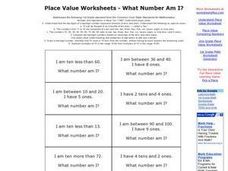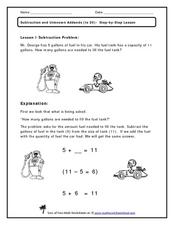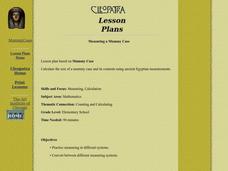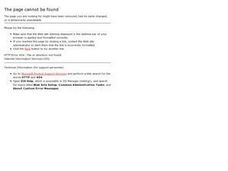Pennsylvania Department of Education
Comparing Sets
Young scholars count back with cubes to model subtraction problems. In this subtraction lesson plan, students compare sets of problems and record their results in a table.
Curated OER
Equal Shmequal by Virginia Kroll
Students read a book and complete exercises to explore the meaning of 'equals.' In this equal numbers lesson, students brainstorm the meaning of equals and read a story about the topic. Students use manipulatives to study balance and...
Curated OER
Find Minimum and Maximum
In this math worksheet, students analyze 24 groups of 6 numbers each. Students write the minimum number and the maximum number in each set. There are no examples; it appears that students are to write the biggest and smallest numbers in...
Pennsylvania Department of Education
Adding and Subtracting Three-Digit Numbers by Jumping
Second graders use data to graph information and draw conclusions. In this instructional activity on data analysis, 2nd graders practice gathering, sorting, comparing, and graphing data. Students differentiate data that can and cannot...
Curated OER
Same and Different
For this mathematics learning exercise, learners first complete the tens place and then add the rest. Then they continue the patterns and compare each column. Students also fill in the missing addends and solve various word problems by...
SEN Teacher
Dice Printer
Let the dice decide your fate with this custom site that creates a die printable based on your needs. Pick from different sizes and custom label each face to use for fun activities.
Curated OER
Place Value
Second graders use physical models to represent and demonstrate place value concepts by using base-ten blocks and hundreds charts. They compare numbers to see which number is smaller or larger and put numbers in order from smallest to...
Worksheets Plus
Place Value Worksheets - What Number Am I?
Practice place value with this resource. The 12 questions consist of riddles. For example, "I have 4 tens and 2 ones. What number am I?" This is a creative approach to thinking about double-digit numbers. Answers are available so you can...
Curated OER
Add and Compare enrichment 10.5
In this addition worksheet, students add the ones columns and fill in the carry squares, add the tens, then order the sums. Students solve ten problems.
Curated OER
Addition and Subtraction Up to Two-Digits
In this finding the sums and differences worksheet, students write the equations in the ones and tens columns and solve and also solve vertical problems with and without regrouping. Students solve 18 problems.
Curated OER
Create and Solve
In this number sentences learning exercise, students practice adding the single digit numbers and comparing the given numbers by creating number sentences and solve the addition problems.
Curated OER
Telling Time, Part 2
Compare time on an analog clock and a digital clock with a learning exercise that prompts third graders to write the given times into both clocks. An example at the top of the page demonstrates how to write the time for both clocks. A...
Curated OER
Place Value: Tens and Ones
In these recognizing tens and ones worksheets, learners count the rods and units and write the numbers in the tens and ones columns, write the correct numbers for the given tens and ones, covert words to the correct numerals, and...
Curated OER
Subtraction and Unknown Addends (to 20)
How many more gallons of fuel does Mr. George need to fill his car to capacity? This word problem uses the unknown addend strategy to get scholars subtracting and thinking about the relationship between mathematical operations. There is...
Curated OER
Math in English Skills III Exercise Book: Understanding Fractions
Fractions can be tricky, and there is no better way to tackle tricky topics than with a visual representation. Intended for learners in grades two and three, this set of printable worksheets provides a variety of fractions represented in...
Curated OER
Yummy Math
Young mathematicians use bags of Skittles to help them gain practice in graphing and organizing data. They work in pairs, and after they have counted and organized their Skittles, they access a computer program which allows them to print...
Curated OER
Counting and Calculating
In this math worksheet, students follow the basic activities that are shown in the planning guide written for the teacher. The plan is written in the form of a unit.
Curated OER
Regrouping
Learners practice regrouping using the wonderful manipulative - unifix cubes. Once they have a tactile understanding of regrouping, students complete 5 worksheets containing addition problems that require regrouping. The worksheets...
Curated OER
Examining Estimation
Second graders participate in various activities which help them explain and explain the difference between an estimate and an exact amount.
Curated OER
Dividing into Two Parts — Halves
In this fractions learning exercise, students divide pictures into halves to introduce them to fractions. Students complete 3 sets of problems.
Curated OER
Measuring a Mummy Case
Students calculate the size of a mummy case and its contents using ancient Egyptian measurements.
Curated OER
Chart Trivia
Students practice addition and subtraction problems and answer questions using greater than and less than. They chart information to create a graph on the computer.























